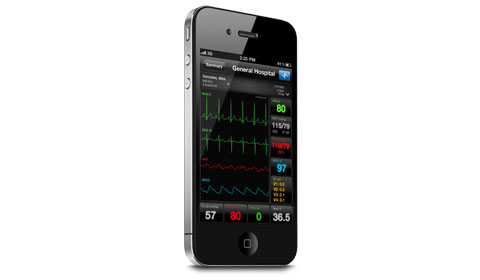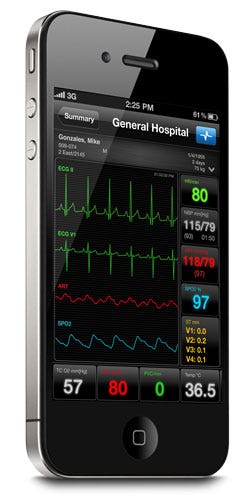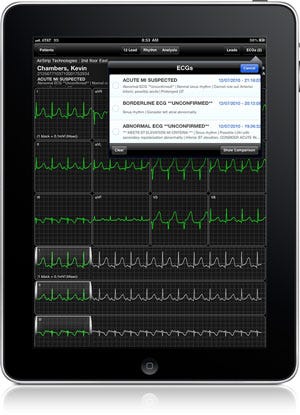AirStrip Technologies (San Antonio, TX) has been getting a lot of attention lately for its mobile platform, which enables physicians to access critical patient information from hospital monitoring systems, bedside devices, and electronic health records. The platform enables physicians to obtain “real-time data from real-time devices such as ICU monitors, maternal fetal monitors, ECG monitors, and so forth,” says vice president of wireless health, global strategy and market development at Qualcomm Life, which recently announced an investment in and partnership with the firm.
February 22, 2012

AirStrip Technologies (San Antonio, TX) has been getting a lot of attention lately for its mobile platform, which enables physicians to access critical patient information from hospital monitoring systems, bedside devices, and electronic health records. The platform allows physicians to obtain “real-time data from real-time devices such as ICU monitors, maternal fetal monitors, and ECG monitors,” explains Don Jones, vice president of wireless health, global strategy and market development at Qualcomm Life, which recently announced an investment in and partnership with the firm.
 At present, the technology is primarily used for patients in the hospital. It could also be used to help physicians monitor their patients at home. “I think really the overall Mecca here is that one day this type of information would be available anytime, anywhere, to people making critical decisions,” says Anthony Shimkin, senior director, marketing at Qualcomm Life.
At present, the technology is primarily used for patients in the hospital. It could also be used to help physicians monitor their patients at home. “I think really the overall Mecca here is that one day this type of information would be available anytime, anywhere, to people making critical decisions,” says Anthony Shimkin, senior director, marketing at Qualcomm Life.
Additional Partnerships
In addition to the recent investment from Qualcomm, AirStrip announced ahead of the HIMSS 2012 event that it had received further funding form Hospital Corporation of America (HCA). The partnership will also expand HCA’s use of AirStrip’s mobile patient monitoring software and cardiology products in its hospitals.
At Healthcare Information and Management Systems Society
(HIMSS) in Las Vegas, the company also announced a partnership with Diversinet Corp. Specifically, it will use the company’s MobiSecure security validation platform, which will enable AirStrip’s products to conform to Federal Information Processing Standards (FIPS) requirements. “As we are starting to mobilize data outside of a hospital, this adds extra security,” says Alan Portela, AirStrip CEO.
A (Very) Brief History
The company was founded by Cameron Powell, MD, an obstetrician-gynecologist who stopped practicing medicine to develop AirStrip Ob, which mobilized in tracking fetal traces for obstetrics.
Over time, the company began to branch out in terms of applications for the technology, which is now used for ambulatory care, cardiology applications, and patient monitoring. “We have moved beyond the four walls of a hospital,” Portela says.
Tapping the Power of Mobility
Decentralization of healthcare is a favorite topic of Portela’s, who has worked in the healthcare IT for nearly 20 years. That background gives him a unique perspective on the electronic medical records (EMRs). “I always knew that EMRs are basically platforms—like an operating system is to your PC,” he says. “The real benefit in terms of workflow improvement can be realized by connecting technologies to the OS and also launching apps on top of your platform.”
When Portela was invited to become the CEO or AirStrip, he noticed that the company was frequently invited to give talks at medical centers and conferences on the topic of mobile monitoring. “But they were talking about us as if we were the future,” he says.
As it turns out, however, the future may have been nearer than they realized. Many of the firm’s hospital customers are now implementing EMRs and EHRs. After the systems are up and running, mobile monitoring is among their highest priorities.
Trends in Mobile Health
Another important trend affecting the mobile healthcare sector is the steady increase in hospital beds that are being monitored. “If you look at the industry about three years ago, we had 70,000 hospital bed that were monitored [in the United States],” Portela says. “Today, we have 300,000.” If the trend continues as expected, within the next three to five years, there will be 800,000 monitored beds. “The reason that this is happening is that it is very well known that there is a shortage of caregivers,” Portela says. “You need to have the data accessible to physicians wherever they are.”
 Another important trend has been the decrease in numbers of primary care physicians and a corresponding increase in physicians who specialize in treating in treating chronic diseases such as cardiovascular disease, diabetes, and so forth. “Today, 70% of the population has at least one chronic disease,” Portela says. The cost of treating these diseases is $1.8 trillion annually. That’s obviously a sizable of the $2.5 trillion that is spent each year on healthcare.
Another important trend has been the decrease in numbers of primary care physicians and a corresponding increase in physicians who specialize in treating in treating chronic diseases such as cardiovascular disease, diabetes, and so forth. “Today, 70% of the population has at least one chronic disease,” Portela says. The cost of treating these diseases is $1.8 trillion annually. That’s obviously a sizable of the $2.5 trillion that is spent each year on healthcare.
As the reimbursement model transitions away from a fee-for-service model to an outcomes-based model, hospital executives are forced to look at healthcare anew. Remote monitoring will be a crucial component as care becomes more patient-centric. In addition, the interest in monitoring patients at home is also building. If a patient gets discharged with a heart condition and returns within 30 days, the hospital gets penalized, Portela explains.
The avoid that outcome, hospitals can “virtualize” their specialist physicians who can monitor their patients wherever they may be—in the hospital or at home. And for that to happen, physicians need access to real-time patient data.
Another important consideration will be analytics. Portela gives this hypothetical scenario: “I can be a physician looking at 100 patients that I need to monitor on a regular basis, who are not just in the hospital but some of whom are at home. An analytics tool could tell me: out of the hundred patients that I am looking at, there are five that are decompensating,” he says. Then, the physician could send a case manager to be able to see what is wrong with that patient.
Reassessing the Healthcare Business Model
Many hospitals plan on laying off employees in anticipation of the reimbursement changes in October. “My message to those organizations is that you need to cover the patients at home,” Portela says. Hospitals should think twice before letting people like case managers go. “Actually, you are going to need to rehire them, redeploy them in a new model to support home monitoring,” Portela says. “Because the more you do that, the more patients you get in your system, the more reimbursement you get,” he explains. “So this is actually a good business model.”
"My closing comment is that healthcare industry is going to be able to use technology to address the needs to improve the quality of care, reduce cost, and create new revenue models based on reimbursement," Portela says. "And I am not just talking AirStrip and mobility; I’m talking about the healthcare industry and healthcare technology in general."
—Brian Buntz
Brian is the editor-at-large at UBM Canon's medical group. Follow him on Twitter at @brian_buntz.
You May Also Like


